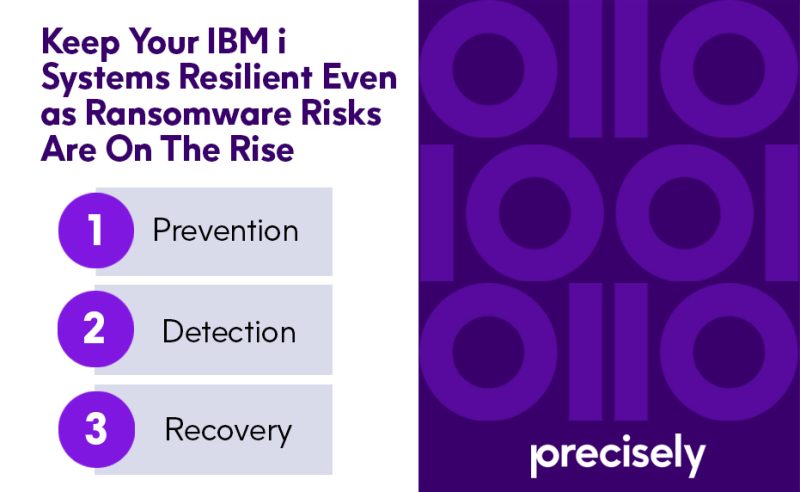
Ransomware Attacks: 3 Keys to Resilience for Your IBM i Systems

Key Takeaways:
- In the face of ransomware attacks, a resilience strategy for IBM i systems must include measures for prevention, detection, and recovery.
- Built-in security features and enterprise-wide security operations help create a robust defense against ransomware.
- AI-driven tools are emerging to help you combat these attacks more efficiently and effectively.
Ransomware attacks have become one of the most significant threats facing organizations worldwide. No platform is immune, not even the reliable and secure IBM i systems.
As you rely more heavily on interconnected digital ecosystems, your susceptibility to ransomware increases, and so does the need for comprehensive strategies to mitigate these risks.
So, how can you keep your IBM i systems resilient even as ransomware risks are on the rise? It involves a comprehensive strategy with three key elements:
- Prevention
- Detection
- Recovery
Let’s explore each of these elements in more detail, along with the overall importance of operational resilience.
What is Operational Resilience, and Why Does it Matter?
Operational resilience refers to your organization’s ability to continue functioning even when disruptions occur, whether due to natural disasters, system failures, or cyberattacks.
These days, the need for resilience is heightened even further by emerging regulatory requirements like the EU Digital Operations Resilience Act (DORA) and the U.S. Strengthening American Cybersecurity Act (SACA). These regulations mandate that organizations not only secure their data but also ensure that their IT systems can quickly recover from disruptions.
For IBM i environments, this means that traditional approaches – like maintaining system logs, backups, and disaster recovery plans – are no longer enough. You need a more comprehensive resilience approach that integrates prevention, detection, and recovery to protect your critical data and ensure business continuity.
Prevention
To prevent ransomware attacks from entering your IBM i systems, you need to understand how the ransomware infiltrates those systems to begin with. This typically involves a multi-step process that begins with gaining unauthorized access, followed by encryption and exfiltration of critical data.
To avoid this process from even beginning, there are some essential preventive measures you can implement, including:
- network segmentation, which helps limit access to the most sensitive areas of your network
- multifactor authentication (MFA), which ensures only authorized personnel can access critical systems
- AES (advanced encryption standard) encryption, which protects data by making it unreadable without a decryption key
IBM i’s integrated file system (IFS) is a common target for ransomware due to its exposure through network shares and mapped drives. Ensuring that IFS access is tightly controlled can be a game-changer in preventing ransomware attacks.
How’s that done? It’s essential to implement exit point programs to monitor and restrict access to your IFS directories. By limiting the root directory’s visibility and using advanced encryption methods, you dramatically reduce the attack surface for ransomware.
Read our eBook
A Holistic Approach to Ransomware Protection for IBM i Systems - Integrate prevention, detection and recovery
Read this eBook to learn more about protecting your business against ransomware requires implementing a set of security and operations analytics tools and solutions, and integrating them fully across IBM i and all other enterprise platforms and networks.
Detection
Preventive measures like those we’ve covered are crucial, but it’s important to remember that even with the best preventive measures, no system is impenetrable. And when an attack does break through, you need to catch it in a timely manner.
Detection plays a crucial role in identifying an attack early to minimize its impact. Rapid detection requires isolating infected systems before the ransomware spreads.
IBM i’s built-in security features generate logs that provide deep insights into your system activity. But as ransomware threats become more sophisticated, traditional log analysis might not be enough. That’s why integrating artificial intelligence (AI)-powered security tools is so important – you gain the ability to analyze system logs in real-time, so you can detect anomalies before they become full-blown crises.
For example, AI tools can monitor key indicators of compromise (IOCs), like:
- unusual file access patterns
- suspicious network activity
- unexpected system behavior
By analyzing the vast amounts of data generated by your IBM i systems, AI can quickly identify threats and reduce the time between detection and response.
Additionally, detection shouldn’t be limited to only your internal systems. You need to monitor all devices connected to your IBM i environment, including routers, VPN gateways, and network appliances. Ransomware attacks can exploit vulnerabilities in any of these devices, making them entry points into your network.

Recovery
Once ransomware has infiltrated your system, your focus must shift to recovery – and the key to effective recovery is continuous data protection (CDP), which allows you to roll back to a pre-infection state. This emphasizes the importance of backups stored in secure locations where you can be sure that ransomware can’t corrupt them.
To achieve these rollbacks with minimal downtime, IBM i systems have several robust recovery tools, including FlashCopy snapshots and journal receivers. However, having backups alone isn’t enough. These backups must be frequent and securely stored with proper retention policies.
A major focus of recovery planning is ensuring the integrity and quality of the data being restored. It’s not just about recovering data but recovering clean and compliant data that can be trusted. Without this validation, your organization risks restoring compromised data, which could lead to further disruptions.
Planning for the Inevitable
One of the important aspects of recovery planning is having a well-documented recovery runbook. This document should outline every step necessary to recover from ransomware attacks, including roles, responsibilities, and communication plans. Regular testing of your recovery plan is essential to ensure it remains current and effective.
A well-prepared recovery plan also helps your organization meet regulatory compliance standards. Failing to comply with these standards can result in fines and legal action, further complicating the aftermath of a ransomware attack.
Achieving True Resilience
To achieve true resilience in the face of ransomware attacks, you need a comprehensive, integrated strategy that combines prevention, detection, and recovery. For IBM i systems, this means leveraging both built-in security features and enterprise-wide security operations to create a robust defense against ransomware.
Bringing it all together:
- Preventing ransomware from entering the system requires strong encryption, network segmentation, and multi-factor authentication.
- Detecting ransomware quickly involves using AI-driven tools to analyze system logs in real time and monitor for anomalies.
- Recovery from an attack depends on having frequent immutable backups and a well-rehearsed recovery plan in place.
By implementing these strategies, your organization can build an IBM i environment that’s resilient to ransomware attacks, ensuring business continuity and minimizing the impact of these increasingly common threats.
Operational resilience isn’t just optional anymore – it’s an essential mandate that enables your organization to survive and thrive. To learn more read our eBook A Holistic Approach to Ransomware Protection for IBM i Systems – Integrate prevention, detection and recovery.



